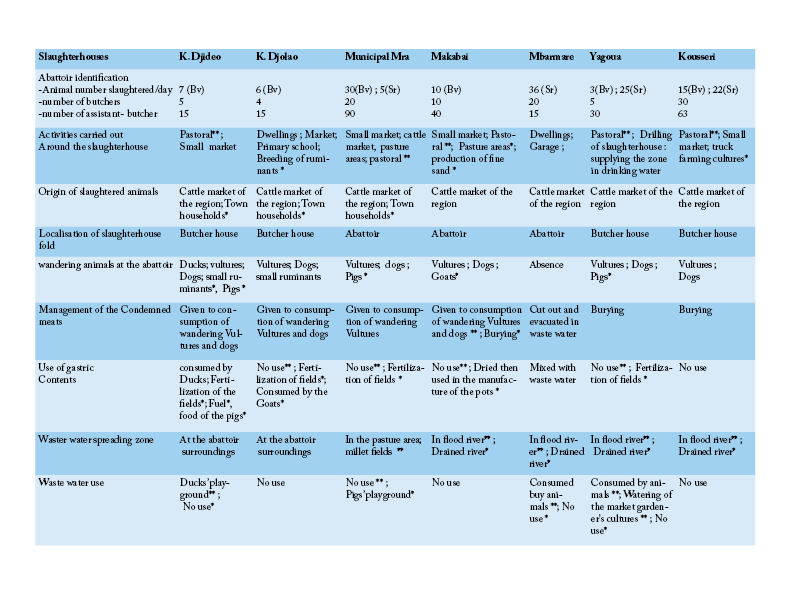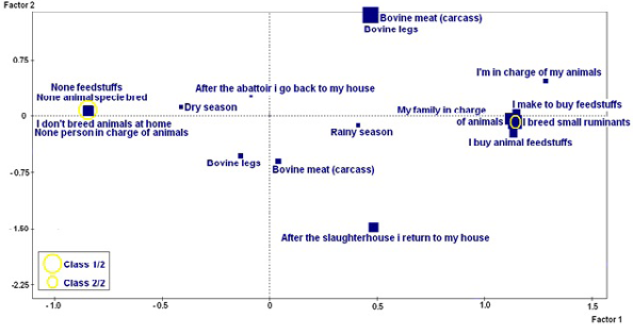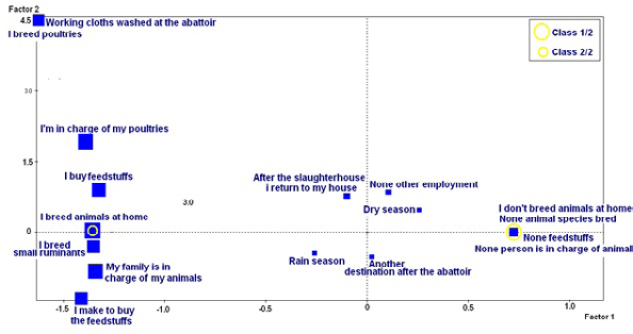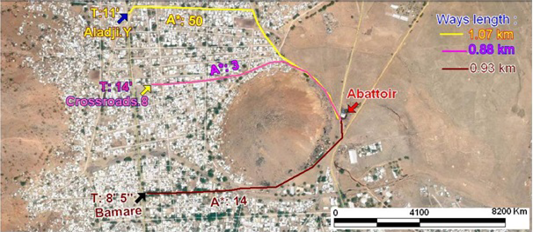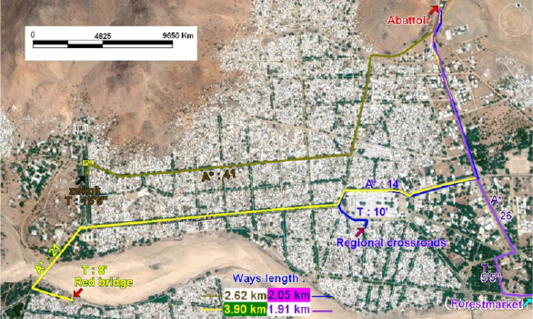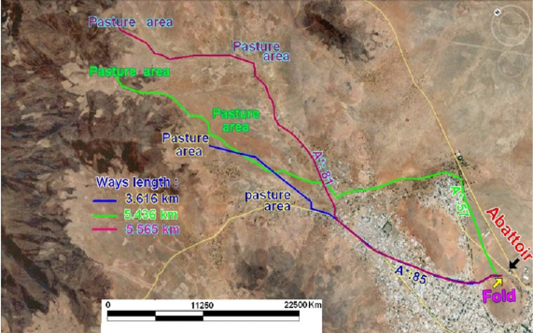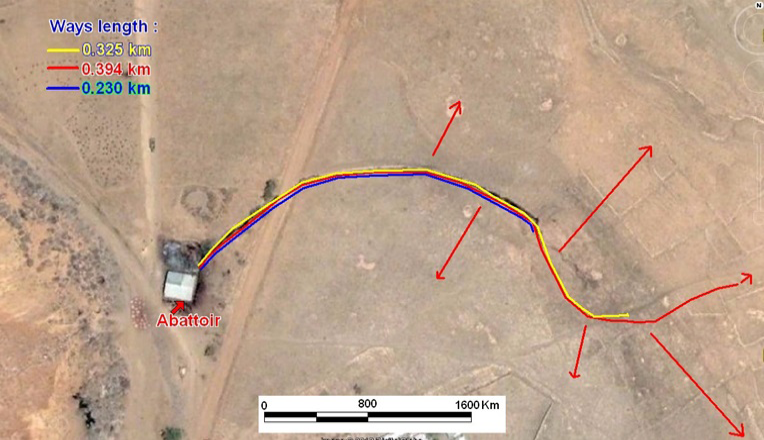Advances in Animal and Veterinary Sciences
Research Article
The Spread of Products of Animal Origin and Wastewaters from Traditional Slaughterhouses in the Far North Region of Cameroon
Raoul Bakari Afnabi1*, Victor Ngu Ngwa1, Mohamed Moctar Mouiche Mouliom2, Sylvain Aoudou Doua3, Rebecca Garabed4
1Department of Microbiology and Infectious Disease; 2Department of Pharmacy and Pharmacology, School of Veterinary Medicine and Sciences, University of Ngaoundere, P.O. Box 454 Ngaoundere, Cameroon; 3Department of Geography, Faculty of Art letters and Social Sciences, University of Ngaoundere, P.O. Box 454 Ngaoundere, Cameroon; 4Department of Veterinary Preventive Medicine, College of Veterinary Medicine, Ohio State University, 1920-Coffey Road Columbus, OH 43210.
Abstract | A two-phase study was carried out in the Far North region of Cameroon to describe the factors that could contribute to the spread of pathogens in animals kept in town, through traditional slaughterhouses. Seven traditional slaughterhouses located in the three main cities of this region (Maroua municipal, Kongola Djidéo, Kongola Djolao, Makabai, Mbalmaré, Kousséri and Yagoua municipal) where selected to conduct the first stage of this study. The different possible outlets of contaminated agents were identified in the first stage. They include, people working at the slaughterhouses, animal products (meat, skins, meat offal, etc), waste waters and animals in lairage prior to slaughtering. The second stage was a further study, which focused on the spread of potentially contaminated products through the municipal slaughterhouses of Maroua and Yagoua. To this end, a questionnaire was randomly administered to 224 slaughterhouses workers (160 at Maroua and 64 at Yagoua). Products (carcasses, animals in lairage prior to slaughtering, wastewaters) emanating from the Maroua and Yagoua slaughterhouses were tracked and followed 78 and 12 times respectively, using Global Positioning Systems (GPS). The results showed that, traditional slaughterhouses could contribute to the propagation of potential pathogens in ruminants reared in town.
Keywords | Slaughterhouses, Pathogens, Ruminants, Far North region, Cameroon
Editor | Kuldeep Dhama, Indian Veterinary Research Institute, Uttar Pradesh, India.
Received | August 21, 2016; Accepted | November 26, 2016; Published | December 02, 2016
*Correspondence | R Bakari Afnabi, Department of Microbiology and Infectious Disease, School of Veterinary Medicine and Sciences, University of Ngaoundere, P.O. Box 454 Ngaoundere, Cameroon; Email: [email protected]
Citation | Afnabi RB, Ngwa VN, Mouliom MMM, Doua SA, Garabed R (2016). The spread of products of animal origin and wastewaters from traditional slaughterhouses in the far North Region of Cameroon. Adv. Anim. Vet. Sci. 4(12): 619-629.
DOI | http://dx.doi.org/10.14737/journal.aavs/2016/4.12.619.629
ISSN (Online) | 2307-8316; ISSN (Print) | 2309-3331
Copyright © 2016 Afnabi et al. This is an open access article distributed under the Creative Commons Attribution License, which permits unrestricted use, distribution, and reproduction in any medium, provided the original work is properly cited.
Introduction
Cities of the Far North (FN) region of Cameroon today bring together several families involved in farming as a source of savings (Thys, 2006), which constitute the population’s main protein supply in animal protein, which is mainly provided by the bovines from Chad (Labonne et al., 2003). This protein supply enters the meat production system through the traditional slaughterhouses present in the cities of this region. These are slaughter structures which existing from the period of independence (Athman et al., 2013), and located today in urban areas (conglomerations), following the expansion of these cities, where they feature today amongst houses. Some of these house owners own domestic animals. In this light, untreated residual water and slaughtered animal waste are released in the environment, exposing city animals to contamination. The lack of information on the sanitary status of slaughtered animals (Afnabi et al., 2014), associated with the proximity between domestic ruminants and traditional slaughterhouses of the FN’s cities highly increases the risks of hazard problem related to the spread of virtual pathogens originating from slaughtered animals. In fact, very few studies were done in this domain (Delia et al., 2015; World Bank, 2009), which is overshadowed by investigations on concepts presenting slaughterhouses as sites of zoonoses transmission transmission (Klous et al., 2016; Bakari et al., 2015; Saidu et al., 2015). The relevance of this study is in that; it attempts to analyze the spread of potentially contaminated products from diseased animals in traditional slaughterhouses in the Far North region of Cameroon. The main objective of this study is, to understand the spread of virtually contaminated substances containing pathogens, from slaughtered animals in traditional slaughterhouses in the Far North region of Cameroon. To achieve this goal, we analyzed the various possibilities of direct and indirect contacts between animals and products emanating from slaughterhouses; animals and slaughterhouses’ wastewaters; animals and animals in lairage prior to slaughtering and finally the behaviours, dispersal and movements of humans from the slaughterhouses after work.
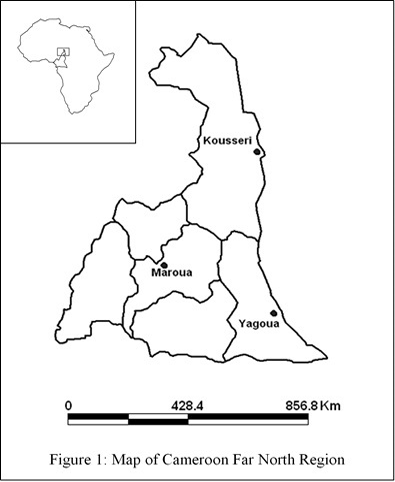
Figure 1: Map of Cameroon Far North Region
Materials and methods
Period of Study
This study was conducted from September 2011 to May 2012 in the Far North Region of Cameroon (Figure 1). The first stage of this work was executed between September to December 2011 (period I) and the second phase throughout the months of April and May 2012 (period II). The activities carried out during period I consisted in a preliminary studies of the slaughterhouses of this region, followed by thorough investigations of two slaughterhouses, selected based on the preliminary results. The in-depth investigations were based on tracking routes travelled by products stemming from the targeted slaughterhouses and a survey on destinations and behaviours of slaughterhouses workers (towards their animals) after work. For period II, the approach used in the first stage was simply reproduced to compare the two situations.
Preliminary Studies
Some preliminary studies were carried out in Maroua, Yagoua and Kousseri. The choice of these cities was mainly based on the demographic importance of their populations. Seven slaughterhouses were chosen, namely; the municipal slaughterhouse of Maroua (MSM), Makabai, Kongola Djolao (K. Djolao), Kongola Djideo (K. Djideo), Mbarmaré, Yagoua (MSY), and Kousséri. These primary investigations were based on the activities observed in slaughterhouses, in their neighbourhood as well as the pre-investigation realized intended for the main slaughterhouse heads (The chief butchers, his assistants and officials of the meat sanitary inspection).
The Data on the identification of slaughterhouses were supplied by the monthly reports of the services of the Regional Delegation of the Ministry of Livestock. At the end of the preliminary work, the MSM and MSY were selected for further study. MSM, was selected for its large size and because it grouped all the characteristics observed in other slaughterhouses in the region. MSY was chosen because of its small size and because Yagoua city is one of the areas where pig breeding is very developed (MINEPIA, 2009).
As for MSM, a pilot study was led in parallel to the preliminary studies of the period I to determine the sample size of the people capable of being questioned during the thorough investigations.
Investigations
The preliminary study enabled the identification of three groups of slaughterhouse attendants, which are, the butchers, the assistant-butchers and the other-people (such as meats buyers, food sellers, curious people, food products buyers, meat carriers). This identification eased the administration of questionnaires to determine the habits of slaughterhouses attendants and their behaviours towards animals after leaving the slaughterhouse. The questions asked enabled respondents to provide more specifications on the directions taken after leaving the slaughterhouse. That is why, the series of questions developed, centered on the respondents place of residence; their destinations after leaving the slaughterhouse; the animals they kept at their home; the animals species bred; the people in charge of their animals and the process of acquisition of their animal food (fodder). Besides, the assistant-butchers and other-peoples were questioned thoroughly on the probability of their passage through pasture zones after leaving the slaughterhouse. Other activities practiced related to the manipulation of animals, cleaning the slaughterhouse and working attires were additional questions, which were asked to the assistant-butchers.
The language commonly spoken in the city of Maroua is Fufulde and that of Yagoua is Massa. That is the reason why the questionnaires was designed in French and translated in Fufulde and Massa. The result of the pilot study (phase I) retained a sample of 80 people including 20 butchers, 23 assistant-butchers and 37 other-people, chosen at random (Giannelloni and Vernetti, 2001). The MSY small size led to the census of people often present at the slaughterhouse for the administration of the questionnaire. This enabled the random selection of 32 people made up of 4 butchers, 14 assistant-butchers and 14 other-people for the questionnaire’s survey. The same samples size was applied in the period II investigation.
Products Routes
The products routes (carcasses, animals in lairage prior to slaughtering, residual waters) resulting from the MSM and MSY were followed during period I and II. The meat carcasses were followed three- times throughout period I and also three- times during period II. In all, 11 meats carcasses routes were identified from the MSM and followed 66 times. While the MSY was found just 1 transport route which was stalked 6 times.
The transport span of the carcasses between the slaughterhouse and the various sale points were recorded and their itineraries were followed. Animals in lairage prior to slaughtering were followed at the MSM because MSY had no fence to keep these animals. Three main routes were identified during the two periods considered. In period I, slaughterhouse animals took two paths and in period II, animals earmarked to slaughter followed just one path. The frequency of the itinerary-followed was made at the rate of two tracking for each route respective to the period considered. On the other hand, when tracing meat carcasses routes and animals kept for slaughter, the number of ruminants encountered on these roads was recorded. The GPS coordinates of the various traffic lanes of products stemming from slaughterhouses were equally identified for their dispersal to be represented on a map. The courses of wastewaters emanating from slaughterhouses were traced in respect of the previous trackings. In total, the products of the MSM and MSY were followed 78 and 12 times respectively during this research.
Data Analysis
A table containing all the topics relative to the observations, the functioning and the environment of slaughterhouses was elaborated with Microsoft Excel 2007, enabling a regular data record. GPS data was analyzed with Map Source software, Microsoft Excel 2007 and Map Info. An average comparison was made with Statistica 6.1 software to analogize the various numbers of animals encountered on the slaughterhouses’ products roads. As regards questionnaires, they were analyzed with software Sphinx plus2. Multiple correspondence factoral analysis (MCFA) (Lebart et al., 1995a) were applied to quantify and determine the importance of associations between the various behaviors highlighted by the survey. A Hierarchical Cluster Analysis (HCA) using the Ward aggregation criterion (Lebart et al., 1995b) allowed tidying up the various groups of slaughterhouses workers according to the high-risk habits and behaviors towards animals’ health. The MCFA and the HCA were realized with the help of SPAD software.
Results
Preliminary Studies
The interviews conducted with the heads of slaughterhouses revealed that several activities took place within the Slaughterhouses, which varied according to seasons (pastoral activities) (Table 1). The animals reserved for slaughtering came from cattle markets of the region, where butchers stocked up at least twice a week. Livestock which was more concerned by this cyclic purchase were regularly driven to pastures until slaughtering. These abattoirs were par excellence linking points for several wandering animals (carnivores, vultures, small ruminants, pigs etc.), among which, small ruminants and pigs were more present in the dry season. As concerns slaughterhouse wastewaters, they were mainly poured in the rivers or grazing areas. In all the seven investigated slaughterhouses, water supply spots were all commonly used by the slaughterhouses and their surrounding populations.
Outcome of the Questionnaire
Origin and residence of Slaughterhouse workers: The questions answered at the end of this study shows that 45%, 38% and 33% of butchers, assistant-butchers and others-people respectively reside in the Doualare area. The remaining others live in twenty- six others districts of Maroua city. In Yagoua, 50% of butchers, 42% of assistants-butchers and 30% of others- people reside in the districts of Xava II, Danay and in the slaughterhouse neighbourhoods, respectively. Fifteen other districts accommodated the remaining group. At the MSM level, 82.5% of butchers and 50% of assistants-butchers headed to their sales counters (11 on average) to assist their bosses. The remaining 17.5 %, 25% and 43% of butchers, assistants-butchers and others-people, respectively, headed towards their homes.
*: Present only in the dry season; **: Present only in rainy season, Bv for bovine and Sr for small ruminan
As regards the practice of other activities by slaughterhouse workers after closing hours revealed that, 25% of assistants-butchers have other varied activities which include, automobiles or motorcycles mechanics, motorcycles washers and grilled meat sellers. Among other slaughterhouse workers, 18 % roam in the city (itinerant salespersons), while 18 % headed to the various markets in Maroua. As for the MSY, 62 % of butchers and 62 % of assistants-butchers headed towards the central market of Yagoua (the city’s main meat market) after closing hours. Then 38%, 30% and 86% of butchers, assistants-butchers and others-people respectively headed towards their homes. The city routes were used by 15 % of assistants-butchers (Motorcycle and Taxi drivers) and 14 % of the others-people.
As concerns other activities carried out by assistants-butchers after work at the slaughterhouse, we have 25 % of them who had other occupations such as; rural works, building, veterinary services and Koranic education (teaching).
Habits and Behaviour of Slaughterhouse Workers
The traditions and attitudes developed towards animals by these various groups of people at the Maroua and Yagoua slaughterhouse are shown in Table 2.
Butchers: The analysis done on butchers indicates that the factorial axis I quantifies at 32 %, the importance of the connections between this group’s behaviour, at the MSM. Figure 2 presents the level of axis I, an association between the behaviour which marks an ascendancy of the indirect contacts (Table 2) on the direct contacts (Table 2) between the butchers and their small ruminants. For the MSY, the axis I describes 43.69 % of associations between the butchers behaviors. The modalities involved in these connections show that the butchers regularly have direct contacts (Table 2) with their animals.
Table 2: Regularly executed contacts by the interviewed persons
|
Contacts type between persons and ruminants |
Behaviors defining the type of contact |
|
Directs contacts |
Directly Go back home after the slaughterhouse+ Breed the small ruminants + I’m in charge of my animals after the abattoir |
|
Breed the small ruminants + after the abattoir, takes care of his animals himself |
|
|
Indirects contacts |
Passage by the pasture tracks after the abattoir |
|
Buy feedstuffs |
|
|
Directly Go back home after the slaughterhouse + Breed the small ruminants |
|
|
Working clothes washed at home + Breed the small ruminants |
Assistant-butchers: The axes I and II represent 44.81% (MSM) and 41.03% (MSY) of the associations between the assistant-butcher’s behaviours (Table 3). For the MSM, the axis I evoke a strong link between the behaviours reflecting indirect and regular contacts between the assistant-butchers and their small ruminants through the purchase of feedstuff (Figure 3).
Table 3: Eigenvalues of factorial axis
|
MSM |
MSY |
||||
|
Abattoir persons groups |
Axes |
Eigen values |
% |
Eigen values |
% |
|
Butchers |
Axis 1 |
0.56 |
32.31 |
0.6 |
43.69 |
|
Assistant- butchers |
Axis 1 |
0.42 |
26.28 |
0.43 |
27.05 |
|
Other- persons |
Axis 1 |
0.53 |
32.65 |
0.68 |
49.84 |
|
Axis 2 |
0.19 |
11.78 |
- |
- |
|
While at the MSY, the axis I expressed a strong bond between the behaviours contributing to direct contacts (Table 2) between the assistant- butchers and their animals.
Other respondents / Other-people: At the MSM level, the axes I and II eigen values correspond to 44.5 % of associations between the studied variables. The axis I (Figure 4) shows indirect contact preponderance (Table 2) on the direct contacts (Table 2), while axis II denotes that the superiority of this contact is most frequent in dry seasons. For MSY, The axis I estimates the greatness of associations between the behaviour modalities at 49.84 %. The main interested behaviour indicates a predominance of the direct contacts (Table 2) on the indirect contacts (Table 2).
Hca: The hca was performed on groups of people at each slaughterhouse allowing us to associate them according to classes, each class represent a set of individuals with a common described behaviour. Two dominating classes of persons distinguished themselves, notably the classes 1/2 and 2/2 (Figure 2, 3 and 4). The class 1/2 included the persons who did not own animals while the 2/2 class gathered people who owned small ruminants. At the level of MSM, the class 1/2 was constituted of 57.5%, 65% and 70% of butchers, assistants-butchers and of the others-people, respectively. Meanwhile, the MSY consisted of 35%, 33% and 40% of butchers, assistants-butchers and others-people, respectively of the same class. According to one person’s distribution, class 2/2 present, 42.5%, 25 % and 30% at the MSM and 75%, 66% and 60%, respectively.
Slaughterhouse Products Routes
Carcasses’s routes: The distances covered by the MSM carcasses revealed three types of routes (Figure 5, 6, 7); the average number of animals encountered by carcasses over small distances ranged from 14 (Bamare) to 50 animals (Aladji. Y), the largest number of animals’ encountered (17 animals) characterized the road towards the slaughterhouse’s market on intermediate distances. For the routes located in more than 1.5 km, the zokok crossroads destination enabled to see the largest number of animals (41 animals). At the MSY, the carcasses’ route extended over 2.869 km, with 56 animals encountered every 5 min and 75 seconds.
Itineraries of animals in lairage waiting for slaughter: The stalking of animal in lairage in slaughterhouses moving for pastures (Figure 8) shows that; in the MSM, more animals are taken away from the slaughterhouses in rainy season (5.565 km). The average distance covered by these animals during the dry season was shorter (3.616 km). the routes of animals towards the pastures was always done via a part of the town, where the number of animals encountered was higher in dry season (85 animals) and relatively lower during the off-season (57 animals). In Yagoua city, the animals destined for slaughter were not kept at the slaughterhouse. The variance analysis relative to animals that came into contact with slaughterhouse products reveals a non- significant difference between the period I and II (P = 0.921 in the MSM; P = 0.954 in the MSY).
Courses of Wastewaters: Investigations carried on the evacuation of residual waters showed that, the spreading areas of these fluids was wider (0.394 km) at the MSM during the rainy season, as compared to other periods of the year (Figure 9). For the period II (dry season) the wastewaters bed, ran over a distance of 0.23 km from the slaughterhouse. At the MSY, the effluents flowed into the Danay River.
Discussion
Preliminary Studies
The description of the seven traditional slaughterhouses in the FN region presents these establishments as potential sites of zoonoses and spread of animal diseases. The findings of this study confirms the results established by the World Bank reports (Delia et al., 2015; World Bank, 2009), on slaughterhouses in developing countries. Indeed, animals brought down to the region’s slaughterhouses came from cattle markets, which are flooded by animals stemming from the Chad. However, the intensity of cross-border movement between the two countries owing to transhumance and non-existence regional program for the control of diseases epidemiology in the area, lead to a poor understanding of the status of animals health stemming from this neighbouring country (Ndzingu and Mbunkah, 2010; Lefèvre and Blancou, 2003). That is why, diseased condemned meats were regularly observed in these slaughterhouses, where they revealed the presence of pathogenic germ carriers among slaughtered animals. Thus, the grouping of animals for several days (3-4 days) for slaughter in slaughterhouses besides cattle-breeding areas could be dangerous, because the presence of numerous biological vectors (ticks, insects) which could favour the transmission of potential germs emanating from these animals.
At the slaughterhouses, the presence of roaming animals could contribute to the dispersal of potential pathogen coming from slaughtered animals. This reality was revealed by Matthew and Matt (2012) who showed that animal movements participate in the distribution of animal diseases.
The behaviour of pigs and ruminants in slaughterhouses during the dry season, increased the transportation of pathogens by these animals due to pressure and lack of food during this period, which caused goats to consume the gastric contents of slaughtered animals, Meanwhile, pigs apart from the gastric contents of slaughtered animals also searched for ponds which usually contained wastewaters to wallow in.
The community water point situated in the slaughterhouse’s neighbourhoods and which is shared among slaughter slabs, humans and animals populations, constitutes another medium for germs transmission from natives brought down to animals. The MSM example was characterized by the proximity of a small ruminants market which shared the same water source with the slaughterhouse.
Origin and Destination of the People after the Slaughterhouse
The destinations taken by people after work at the slaughterhouse gave rise to numerous directions covering more than half of the Maroua and Yagoua cities. This reflects a large area covered by men, potential pathogen vector emanating from the slaughterhouse. These diverse orientations after closing hour at the slaughterhouse are logical, because the individuals concerned were mainly traders, who went to sell their products in the various markets of the city (butchers and assistants-butchers), or in the city (peddler among others-persons). Moreover, some assistants-butcher worked as the motorcycles-taxi drivers (secondary activity), this allowed them to circulate throughout the city after the slaughterhouse. The spread field of individuals at the MSM was more important than that of MSY, because of the Maroua city size, which is larger than that of Yagoua.
Mcfa
Butchers: The indirect contacts (predominantly through food) between butchers and their small ruminants were observed at the MSM level. The probable reason for this report is based on the difficult access of animals to food (Sabiiti et al., 2014; Guendel, 2002) and that of the butchers’ social status. Indeed, Maroua town is the administrative centre of the FN regions but also the most urbanized and largest city of the entire region. This development, regularly favours the scarcity of pastures, which benefits dealing by causing small ruminants owners to purchase fodder for their animals. Concerning the social status of butchers rather represents a well affluent category of people, who are more often responsible for large family, reason why they are in charge of purchasing foodstuff but then, the distribution of these food to animals is left to other people hired for this purpose. Foeken and Owuor (2000) revealed similar behaviours in the Nakuru town (Kenya) where 43% of households with high incomes hired the services of extra people to keep their animals. The increase level of education and the mix between the different cultures of the Maroua populations (the man is in charge of the ruminants) and that of people coming from the southern areas, could represent an evolutional mentality which could justify the dominance of the indirect contacts on the direct contacts. For the MSY, the modalities describing the direct contacts are strongly connected and have equal values presenting 43.69 % of the associations. This difference with Yagoua should be put on the account of mentalities, which are still very traditionalist in this zone, though the rate of urbanization and the size of the city is smaller than that of Maroua.
Assistant –butchers: Indirect relationship was highlighted between the assistants-butchers and their small ruminants at the MSM. The reason relating to the availability of fodder resources previously evoked would have the same effect in this group. In addition, slaughterhouses’ personnel are generally constituted of unemployed workers and street boys who earn low salaries. This situation would pushes them to seek for other income generating activities (75% of the assistant-butchers were engaged in another activity), which could result to their incapacity to personally manage their animals. The preponderance of direct contacts at the MSY can be explained with the reasons developed for MSY butchers.
Other-people: At MSM, this group is mainly composed of food sellers (57%) and meats consumers (34%). This structure could justify the ascendancy of indirect contacts (by the pastures and feedstuff) on the direct contact, so far as the activities practiced by these people were periodic. In fact, some food salesmen traded their goods at the slaughter-house to go back towards pastures where the small ruminants could graze on their way home. Other food sellers continued with their product to the market, where they purchased straw or fresh grass for their animals after selling all their goods. The meat customers followed a course similar to that of food product sellers. This indirect contact is predominant in dry seasons, because of the increased pressure of food resulting to the shortage of pastures. The difference between Maroua and Yagoua could also be due to primitive attitude. This is because, at the MSY, the group of ‘other-people’ were (54%) composed in majority by peasant women still attached to local customs and traditions.
Hca: No matter the groups of people concerned, the class of people who owned animals (2/2) and that of those who did not have any (1/2) are mainly distinguished by the hca. The number of people in the class of 2/2 was greater than that of class 1/ 2 at the MSY, whereas the opposite was observed at the MSM. This result suggests that MSY workers’ animals could be more exposed to diseases carried away from the slaughterhouse by their owners. Thus, this could be the probable consequence of the difficulties faced by rearers who keep animals in big cities. Indeed, Maroua city by its size and its level of urbanization could present important problems faced in breeding ruminants (Thys, 2006) what could increase the costs of production, to make this activity less accessible to poor people coming in contact with slaughterhouses.
Tracking of Slaughterhouse Products Routes
Carcasses routes: No matter the distances covered and duration of carcasses on routes, ruminants (the small ruminants mainly) were seen on all roads followed, with rambling as breeding system of small ruminants in the city of Maroua (Thys, 2006). The number of animals encountered on carcasses routes was expected to be proportional to the distance travelled. However, the results obtained showed that the variability of the animals crossed by carcasses depended on the area crossed (Gertel and Said, 2000) and on the duration of financial transactions at the slaughterhouse. As for zones crossed, it turned out that the Doualare zone (Aladji Yaya School) was a peri-urban area, where numerous households practiced ruminant breeding, because of the proximity to the city exit and consequently the proximity of roads to pastures zones (Figure 8). However, the number of animals encountered (3 small ruminants) on the way to crossroads 8 (Doualare zone) is understandable because of its proximity to the hill, leading to the rarity of houses on this route. Intermediate courses (between 1 and 1.5 km) were found in urban centre where main markets and banks are situated. Reason why the number of animals met on carcasses routes was relatively low (≤ 17 ruminants). The duration of transaction between butchers at the slaughterhouse is often responsible for the late circulation of carcasses. This is the case of, the itinerary going towards the artisanal market, where the number of animals crossed (3 small ruminants) was significantly lower than that of the road leading to the slaughterhouse market (17 small ruminants). In fact, carcasses used the same route but at different intervals. So the small ruminants roaming in the city did not cross the same animals at the same time. The course length was also importance, because in the case of diseases such as FMD, pathogen transmission can occur through carcasses which have not yet reached maturity (Sutmoller et al., 2003). This is similar, because carcasses were transported before maturation, which always begins 24 to 48 hours after slaughter (Rhezrani, 2013).
Routes for animals in lairage prior to slaughtering: For the period I and II at the MSM, ruminants were often met twice by animals destined for slaughter on the various city roads and pastures grounds. The contact between city animals and slaughterhouse livestock occurred when the owners of bovines and small ruminants entrusted their animals to slaughterhouse shepherd, who gathered all the animals and led them to pastures. This situation justifies the contacts which exist between slaughterhouses and animals in town. During the off season, the number of animals encountered was little (57 small ruminants) given that animal’s path passed across the less populated area of the city. The statistical analysis of animals met by slaughterhouse products (animals prior to slaughter and carcasses) in the MSM and MSY during the period I and II indicates a non-significant difference between these distributions. This could be explained by the fact that, stray animals generally did not only feed on grass that grew around road borders but also on garbage found by roadsides (Guendel, 2002).
Wastewater routes: At the MSM, the effluents dispersion on pasture was more important during the rainy season as runoff expanded the surface covered by wastewater (Figure 9), leading to a wider dispersal of its potential germs in the environment. This finding corroborated with those of Morales et al. (2015), reveals that the haste rate is one of the major factors that influences wastewater micro-organisms horizontal movements (to the surface of the ground). The supply of these pastures grass by men, established the contacts between the slaughterhouse and livestock raised in the city. Besides, indirect contacts could also possibly take place between these affluent and animals through the intervention of farmers, who plough a zone irrigated by residual waters. Therefore, they were handling affluent mixed with mud, which they would later take back home where farm animals could be. At the MSY level, Danay River during flood periods (period I) served as an affluent transport means. The animals-affluents contacts were done through this river’s water where animals (small ruminants, cattle, pigs) came to drink. This potential infectious transmission channel was revealed by Loukiadis et al. (2010) and Linklater et al. (1985) by describing the respective distribution of Escherichia coli and Salmonella from the slaughterhouse to the affluents.
Conclusion
We observed that contacts are regular between slaughterhouse products and animals bred in the towns of the Far North region of Cameroon. In order to demonstrate that these contacts could transmit pathogens stemming from traditional slaughterhouses, it would be important to carry out other investigations.
Acknowledgments
We would like to thank the United States National Science Foundation which financially supported this study. We give thanks to the Disease Ecology and Computer Modeling Laboratory at Ohio State University and by the Support Centre for Research and Pastoralism (CARPA) in Maroua (Cameroon) who administered this project. Our gratitude also goes to Dr Stanley Fon Tebug and Dr Manchang Tani Kingsley for proof reading the manuscript.
Conflict of interest
We assert that this study has no conflict of interest.
Authors’ Contribution
The first, second and last authors contributed in the realization of the surveys and in the redaction of the manuscript. The first, third and fourth authors carried out the data analysis (statistics and Geographic Information System).
References





